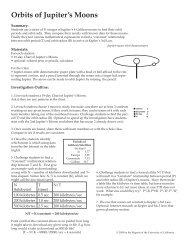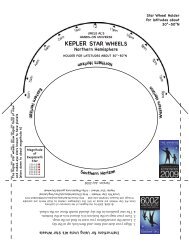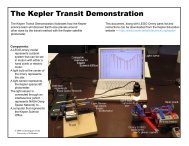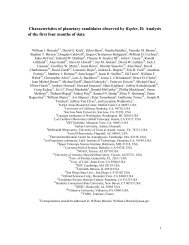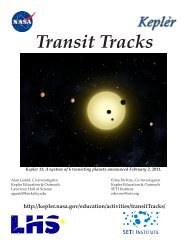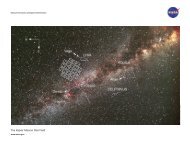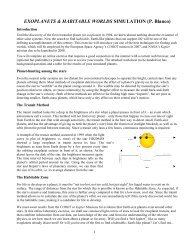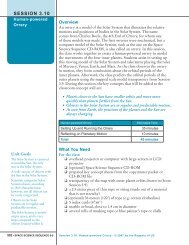Poster Abstracts - Kepler - NASA
Poster Abstracts - Kepler - NASA
Poster Abstracts - Kepler - NASA
- No tags were found...
You also want an ePaper? Increase the reach of your titles
YUMPU automatically turns print PDFs into web optimized ePapers that Google loves.
POSTER ABSTRACTSP0405. POSTER SESSION I S. F. Taylor 1 , 1 National Tsing Hua University Institute of Astronomy, No. 101, Section 2,KuangFu Road, Hsinchu, Taiwan 30013, astrostuart@gmail.com . We explore the tidal migration ofthe hot Jupiter distribution found from <strong>Kepler</strong> data toshow that the three day pile up is consistent with ahigher rate of inmigration for the most massive planets(Figure 1). The manner in which the distribution of themost massive planets turns over closer to the star maybe due to a population of eccentric planets being rapidly migrated towards the star by processes such asplanet scattering and Kozai migration.We show that planets undergoing Roche lobeoverflow may a very long time (Figure 2). Such eventsmay last longer than the 50,000 years which Spezzi etal. [1] (hereafter S11) suggest explains objects theyfound that appear as overluminous bright brown dwarflike objects. S11 found nine objects with temperaturesmore typical of brown dwarfs (BDs) in the massivegalactic cluster NGC 3603 but with luminosities muchtoo high. They conclude that planets filling their Rochelobe provide the best explanation for these objects. Wealso show that planets more massive than Jupiter mayobservably increase the luminosity of the star, but Jupitermass planet might not. We show that a broad rangeof planet masses will migrate outwards during theiroverflow mass loss, but once a more dense core startsto overflow, the planet will migrate back in. Weconsider the hypothesis that the three day pileup of“giant planets” may be a region where inward migration due to planetary tides slows but before migrationdue to stellar tides is strong (where giant planets areconsidered to be at or above one Jupiter mass, or in<strong>Kepler</strong> data, 8 earth radii). In Figure 1, we show thatsuch a scenario would allow for a little higher value oftidal friction, represented by a little lower value of thestellar tidal quality factor . A value of 10 7.5 canbe seen to have maintained a reasonable distribution, while a value of 10 6.5 can be seen to have unreasonablychanged the distribution. A value such as shown herefor = 10 7..0 need not be excluded even if it requires apileup, since a pileup does exist. To comprehensively determine what value of tidal friction is indicated by the <strong>Kepler</strong>distribution will require that the distribution be characterizedwith a pileup (next section). The <strong>Kepler</strong>distribution modeled by [2] did not seek to parameterize thepileup. It is clear from Figures 4 and 7 of [2] that the modified power law found there has not been designed to fit forthe pileup. We are preparing a fit to include a pileup, withthe goal of finding what value of the tidal friction may explain the location of the cutoff. A comparison with the muchstronger three day pileup seen in radial velocity and previoustransit measurements.Figure 1. The distribution of giant planets ( ≥8R Earth ) from <strong>Kepler</strong>, with what distribution this wouldimply 4.5×10 9 years ago for three different values ofthe stellar tidal friction . The <strong>Kepler</strong> distributionfrom [2] is given by the “+” symbols connected by theline, below the other curves. The crosses represent themost tidal friction, or =10 7.5 , the triangles =10 7.0 , andthe diamonds the least tidal friction, =10 6.5 .Figure 2. The migration of a 2 M Jupiter planet hostedby a 1 M Sun star from 4 solar radii to the point of Rochelobe overflow and subsequent outward migration, for =10 6.0 . We will also addresshow common systems with Roche lobe accretion orcollision planet accretion may be. [1] Spezzi, L. et al., (2011) [2] Howard et al., 2011, eprint arXiv:astroph:1103.2541.1642011 <strong>Kepler</strong> Science Conference - <strong>NASA</strong> Ames Research Center



